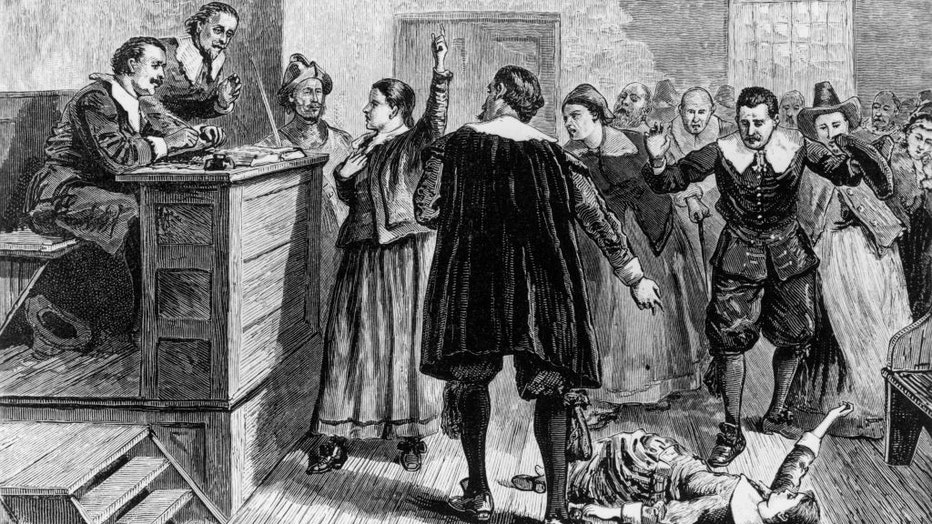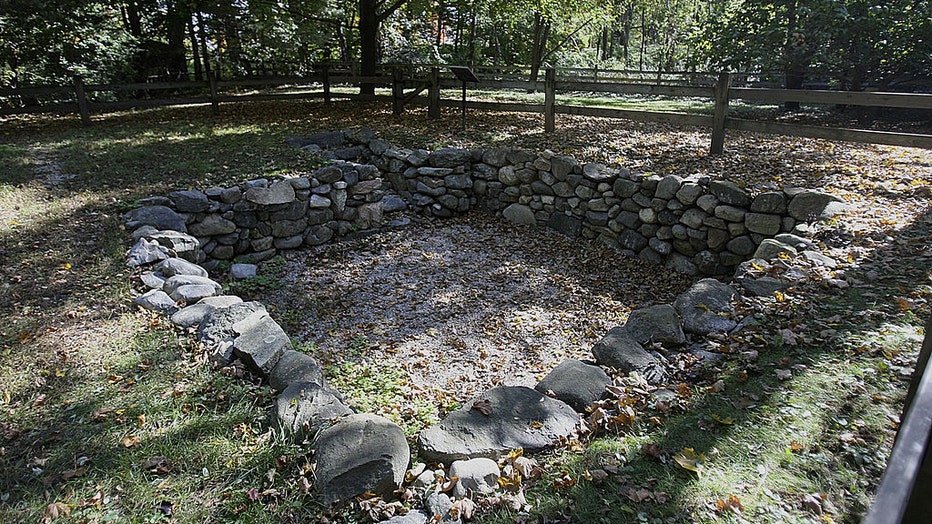How cold weather helped cause the Salem witch trials
The trial of George Jacobs for witchcraft at the Essex Institute in Salem, Massachusetts in 1692. (Photo by MPI/Getty Images)
The Salem witch trials were the largest witchcraft outbreak in American history, resulting from a perfect storm of catastrophes.
Taking place in 1692 and 1693, the Salem witch trials were held in towns across northeastern Massachusetts. The center of the trials was Salem Village, or the modern day town of Danvers, according to Salem State University history professor and author of "A Storm of Witchcraft" Emerson Baker.
More than 150 people were tried during the Salem witch trials, Baker said. Most were locked up in jail for months, and some were sentenced to up to a year or more. Five died in jail, 19 were executed, and one was pressed to death.
Baker noted that the witch hunt phenomenon was a regional crisis, and one that was caused by a perfect storm of factors.

A young woman accused of witchcraft in Salem Village, Massachusetts, tries to defend herself in front of Puritan ministers in 1692. (Photo by MPI/Getty Images)
One reason, particularly in Salem Village, was strife and factionalism as arguments over who the ministers should be, pitting neighbors against one another. Baker noted that this contention in the community laid the groundwork for accusations of witchcraft. In fact, the first people who were accused were the daughter and niece of a reverend who had political enemies.
WHY DO WE CARVE PUMPKINS ON HALLOWEEN?
Additionally, the people in the Salem area worried they were losing their Puritan mission. Most people came to Massachusetts to create their own community where they could worship their own faith. By the 1690s, however, Baker said many people felt that they’d lost that original fervor.
Baker noted that the witch hunt phenomenon was a regional crisis, and one that was caused by a perfect storm of factors.

The frenzy that fueled the witch trials started in Salem Village - now called Danvers - and at the parsonage whose foundation remains. (Photo by Suzanne Kreiter/The Boston Globe via Getty Images)
One reason, particularly in Salem Village, was strife and factionalism as arguments over who the ministers should be, pitting neighbors against one another. Baker noted that this contention in the community laid the groundwork for accusations of witchcraft. In fact, the first people who were accused were the daughter and niece of a reverend who had political enemies.
WHY DO WE CARVE PUMPKINS ON HALLOWEEN?
Additionally, the people in the Salem area worried they were losing their Puritan mission. Most people came to Massachusetts to create their own community where they could worship their own faith. By the 1690s, however, Baker said many people felt that they’d lost that original fervor.
The people of Massachusetts were also concerned about a war they were fighting on the northern frontier, or what is now New Hampshire and Maine, according to Baker. They were battling the Native Americans and their French allies and losing.
Extreme weather causes extreme consequences
On top of the war, religious concerns and political tensions, the people were experiencing a long stretch of inclement weather.
HOW SHAKESPEARE USED WEATHER TO SET THE STAGE IN HIS PLAYS
This was of particular concern for the people of 17th-century New England, as they were a largely agrarian society. Their communities were predominantly made of farmers or people who depended on their gardens to feed their families. So when bad weather struck, it led to crop failures, often starvation, disease and death.
Such a devastating weather pattern was caused by something much larger and more widespread than what the people of Salem might have guessed.
"As it turns out, the Salem witch trials took place in what we now recognize as the Little Ice Age, which was a time of colder climate, more severe weather," Baker said.
HOW THIS MASSACHUSETTS TOWN HONORS THE ANDREA GAIL AND LONG FISHING LEGACY
He noted that the Little Ice Age lasted from about 1400 to 1800, and it caused temperatures to become considerably cooler. According to Encyclopedia Britannica, the temperatures across the Northern Hemisphere during the Little Ice Age dropped by 1.1 degrees Fahrenheit, or 0.6 degrees Celsius, and caused mountain glaciers to expand.
In addition to the drop in temperature, the Little Ice Age brought with it more storms and instability, Baker said.
The Little Ice Age brought cold winters with heavy snowfall; during spring, when farmers would plant their crops, frosts would come in until June. Summers were not much better for replanting; the weather was hot and dry enough to destroy more crops before another frost hit in August and early September.
HOW SCIENTISTS LEARNED ABOUT CLIMATE CONDITIONS HUNDREDS OF YEARS AGO IS ‘BATTY’
"It turns out the 1680s and the 1690s were the absolute most extreme weather of this whole Little Ice Age," Baker said. "This was really extreme weather on an unprecedented scale, and it had consequences."
The severe weather, in addition to war on the frontier, led many Puritans to believe that God was angry at New England for losing its spiritual community. In an attempt to find someone to blame, they held their witch trials.
Baker noted that people in the 17th century sometimes blamed bad weather on witches.
"If a bad storm at sea sank a ship, or if lightening struck and destroyed a house, or if a storm destroyed crops, they often felt a witch might have been responsible," he said.
However, the trials did not lead to better days for the people of Salem and around New England. According to Baker, matters deteriorated for the next several years to the point where they realized the grave mistake they had made with the witch trials.
In 1697, Massachusetts called for a public day of humiliation and fasting. Baker said the occasion involved the colony publicly confessing its sins on how the colony had gone wrong, including being deluded by Satan to execute people for witchcraft.
"It wasn't sort of a full apology, shall we say, but it was as close as the government could come at that point to acknowledging that it might not have been a great thing to execute witches," he said. "Clearly the witches weren't entirely the problem, and there were other things going on."
While the Salem witch trials involved trying more than 150 people across the Atlantic Ocean in Europe, where the Little Ice Age also wreaked havoc, about 100,000 people were tried for witchcraft. Baker noted that about half of them were executed.
"Salem is known as the Witch City, but in fact, it's symptomatic of a much larger problem that, it's kind of a timeless crime that every society has escaped from."
Get the latest updates on this story at FOXWeather.com

